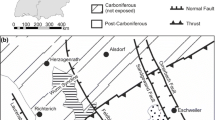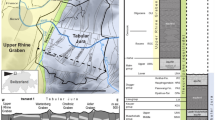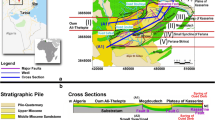Abstract
A 3D geological model of the area east of Basel on the southeastern border of the Upper Rhine Graben, consisting of 47 faults and six stratigraphic horizons relevant for groundwater flow, was developed using borehole data, geological maps, geological cross sections, and outcrop data. This model provides new insight into the discussions about the kinematics of the area between the southeastern border of the Upper Rhine Graben and the Tabular Jura east of Basel. A 3D analysis showed that both thin-skinned and thick-skinned tectonic elements occur in the modeled area and that the Anticline and a series of narrow graben structures developed simultaneously during an extensional stress-field varying from E–W to SSE–NNW, which lasted from the Middle Eocene to Late Oligocene. In a new approach the faults and horizons of the 3D geological model were transferred into discrete elements with distributed hydrogeological properties in order to simulate the 3D groundwater flow regime within the modeled aquifers. A three-layer approach with a horizontal regularly spaced grid combined with an irregular property distribution of transmissivity in depth permitted the piezometric head of the steady-state model to be automatically calibrated to corresponding measurements using more than 200 piezometers. Groundwater modeling results demonstrated that large-scale industrial pumping affected the groundwater flow field in the Upper Muschelkalk aquifer at distances of up to 2 km to the south. The results of this research will act as the basis for further model developments, including salt dissolution and solute transport in the area, and may ultimately help to provide predictions for widespread land subsidence risks.









Similar content being viewed by others
References
Aegerter I, Bosshardt AG (1999) Technischer Bericht–Setzungsproblematik/Massnahmen gegen die Setzungen
Bitterli-Brunner P, Fischer H (1989) Erläuterungen zum Blatt Arlesheim 1067. Geologischer Atlas der Schweiz
Bitterli-Brunner P, Fischer H, Herzog P (1984) Geologische Karte Blatt Arlesheim 1067. Geologischer Atlas der Schweiz
D’Agnese FA, Faunt CC, Hill MC, Turner AK (1999) Death Valley regional ground-water model calibration using optimal parameter estimation methods and geoscientific information systems. Adv Water Resour 22(8):777–790
GMS (2004) Groundwater modeling system v4.0. Environmental Modeling Systems, Inc., South Jordan (Utah), USA
Gürler B, Hauber L, Schwander M (1987) Die Geologie der Umgebung von Basel mit Hinweisen über die Nutzungsmöglichkeiten der Erdwärme. Beitrag zur Geologischen Karte der Schweiz
Harbaugh AW, Banta ER, Hill MC, McDonald MG (2000) MODFLOW-2000, The U.S. geological survey modular ground-water model-user guide to modularization concepts and the ground-water flow process. US Geological Survey Open-File Report 00–92
Hauber L (1971) Zur Geologie des Salzfeldes von Schweizerhalle-Zinggibrunn (Kt. Baselland). Eclogae geol Helv 64(1):163–183
Herzog P (1956) Die Tektonik des Tafeljura und der Rheintalflexur südöstlich von Basel. Eclogae geol Helv 49(2):317–362
Jussel P, Stauffer, F, Dracos T (1994) Transportmodeling in heterogeneous aquifers: 1. statistical description and numerical generation of gravel deposits. Water Resourc Res 30(6):1803–1817
Kovacs A (2003) Geometry and hydraulic parameters of karst aquifers: A hydrodynamic modeling approach.; Thèse de Doctorat, CHYN, Univ de Neuchâtel
Laubscher H (1971) Das Problem von Rheintalflexur und Tafeljura. Eclogae geol Helv 64(1):157–162
Laubscher H (1982) Die Südostecke des Rheingrabens–ein kinematisches und dynamisches Problem. Eclogae geol Helv 75(1):101–116
Laubscher H (2001) Plate interactions at the southern end of the Rhine graben. Tectonophysics 343:1–19
Laubscher H (2003) The Miocene Dislocations in the northern foreland of the alps: oblique subduction and its consequences (Basel area, Switzerland-Germany). Jber Mitt Oberrhein geol Ver 85:423–439
Mallet JL (1989) Discrete smooth interpolation. ACM Trans Graph 8(2):121–144
Mallet JL (1992) Discrete smooth interpolation in geometric modeling. CAD 24(4):178–191
Mallet JL (2002) Geomodeling. Oxford University Press, pp 1–600
Meyer M (2001) Die Geologie des Adlertunnels. Bull Angew Geol 6(2):199–208
Nagra (1988) Sedimentstudie– Zwischenbericht 1988. NTB:88–25
Nagra (2002) Projekt Opalinuston: Synthese der geowissenschaftlichen Untersuchungsergebnisse. NTB:02–03
Noack T (1993) Geologische Datenbank der Region Basel. Eclogae geol Helv 86(1):283–301
Pearson FJ, Balderer W, Loosli HH, Lehmann BE, Matter A, Peters T, Schmassmann H, Gautschi A (1991) Applied Isotope Hydrogeology—a case study in northern Switzerland. Elsevier
Poeter EP, Hill MC (1998) Documentation of UCODE, a computer code for universal inverse modeling. USGS WRIR 98–4080, pp 1–116
Regli C, Rosenthaler L, Huggenberger P (2004) GEOSSAV: a simulation tool for subsurface applications. Comput Geosci 30:221–238
Schmassmann H (1990) Hydrogeologische Synthese des Rheintals zwischen Ergolz und Birs. Bericht des Amtes für Umweltschutz und Energie Basel- Landschaft
Schumacher M (2002) Upper Rhine Graben: role of preexisting structures during rift evolution. Tectonics 21(1)
Thury M, Gautschi A, Mazurek M, Müller WH, Naef H, Pearson FJ, Vomvoris S, Wilson W (1994) Geology and hydrogeology of the crystalline basement of northern Switzerland—synthesis of regional investigations 1981–1993 within the Nagra Radioactive Waste Disposal Programme. Technical Report 93–01
Trösch J, Kuhlmann U, Junghans U, Noack T (1997) Grundwassermodell Hardwald–Modellaufbau und Kalibrierung. TK Consult AG and Geologisch-Päontologisches Institut der Universität Basel, Bericht des Amtes für Umweltschutz und Energie Basel-Landschaft
Wittmann O, Hauber L, Fischer H, Rieser A, Staehelin P (1970) Geologische Karte Blatt Basel 1047. Geologischer Atlas der Schweiz
Zechner E, Frielinsdorf W (2004) Evaluating the use of data on canal seepage and solute concentration in aquifer parameter estimation. J Hydrol 289:62–77
Acknowledgements
We would like to thank the “Amt für Umweltschutz und Energie Basel Landschaft” for funding this project. Many thanks to Kamil Ustaszewski for discussing the regional geology, especially the Adlerhof Anticline–Aspenrain Fault situation. We would also like to thank Karin Bernet, Ray Flynn, Martin Mazurek and David Tanner for their valuable reviews of the manuscript and Ralph Kirchhofer for his technical support during the project.
Author information
Authors and Affiliations
Corresponding author
Rights and permissions
About this article
Cite this article
Spottke, I., Zechner, E. & Huggenberger, P. The southeastern border of the Upper Rhine Graben: a 3D geological model and its importance for tectonics and groundwater flow. Int J Earth Sci (Geol Rundsch) 94, 580–593 (2005). https://doi.org/10.1007/s00531-005-0501-4
Received:
Accepted:
Published:
Issue Date:
DOI: https://doi.org/10.1007/s00531-005-0501-4




